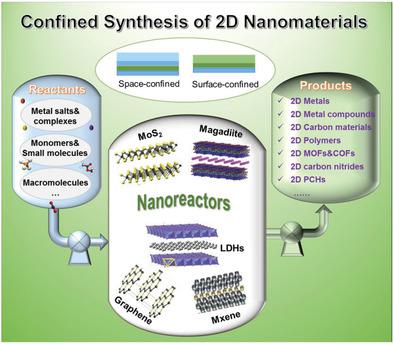当前位置:
X-MOL 学术
›
Adv. Energy Mater.
›
论文详情
Our official English website, www.x-mol.net, welcomes your
feedback! (Note: you will need to create a separate account there.)
Confined Synthesis of 2D Nanostructured Materials toward Electrocatalysis
Advanced Energy Materials ( IF 24.4 ) Pub Date : 2019-04-17 , DOI: 10.1002/aenm.201900486 Zhenhua Li 1 , Xiao Zhang 2 , Hongfei Cheng 2 , Jiawei Liu 2 , Mingfei Shao 1 , Min Wei 1 , David G. Evans 1 , Hua Zhang 2, 3 , Xue Duan 1
Advanced Energy Materials ( IF 24.4 ) Pub Date : 2019-04-17 , DOI: 10.1002/aenm.201900486 Zhenhua Li 1 , Xiao Zhang 2 , Hongfei Cheng 2 , Jiawei Liu 2 , Mingfei Shao 1 , Min Wei 1 , David G. Evans 1 , Hua Zhang 2, 3 , Xue Duan 1
Affiliation

|
2D nanostructured materials have shown great application prospects in energy conversion, owing to their unique structural features and fascinating physicochemical properties. Developing efficient approaches for the synthesis of well‐defined 2D nanostructured materials with controllable composition and morphology is critical. The emerging concept, confined synthesis, has been regarded as a promising strategy to design and synthesize novel 2D nanostructured materials. This review mainly summarizes the recent advances in confined synthesis of 2D nanostructured materials by using layered materials as host matrices (also denoted as “nanoreactors”). By virtue of the space‐ and surface‐confinement effects of these layered hosts, various well‐organized 2D nanostructured materials, including 2D metals, 2D metal compounds, 2D carbon materials, 2D polymers, 2D metal‐organic frameworks (MOFs) and covalent‐organic frameworks (COFs), as well as 2D carbon nitrides are successfully synthesized. The wide employment of these 2D materials in electrocatalytic applications (e.g., electrochemical oxygen/hydrogen evolution reactions, small molecule oxidation, and oxygen reduction reaction) is presented and discussed. In the final section, challenges and prospects in 2D confined synthesis from the viewpoint of designing new materials and exploring practical applications are commented, which would push this fast‐evolving field a step further toward greater success in both fundamental studies and ultimate industrialization.
中文翻译:

二维纳米结构材料的电催化封闭合成
2D纳米结构材料因其独特的结构特征和令人着迷的理化特性而在能量转换方面显示出巨大的应用前景。至关重要的是,开发有效的方法来合成定义明确的2D纳米结构材料,并具有可控的成分和形态。有限合成这一新兴概念已被认为是设计和合成新型二维纳米结构材料的一种有前途的策略。这篇综述主要总结了通过使用层状材料作为基质(也称为“纳米反应器”)在二维合成纳米结构材料的受限合成中的最新进展。由于这些层状主体的空间和表面约束作用,各种组织良好的2D纳米结构材料,包括2D金属,2D金属化合物,2D碳材料,2D聚合物,二维金属有机骨架(MOF)和共价有机骨架(COF)以及二维碳氮化物已成功合成。提出并讨论了这些2D材料在电催化应用中的广泛应用(例如,电化学氧/氢放出反应,小分子氧化和氧还原反应)。在最后一节中,从设计新材料和探索实际应用的角度对2D受限合成的挑战和前景进行了评论,这将推动这个快速发展的领域进一步迈向在基础研究和最终工业化方面取得更大的成功。提出并讨论了这些2D材料在电催化应用中的广泛应用(例如,电化学氧/氢放出反应,小分子氧化和氧还原反应)。在最后一部分中,从设计新材料和探索实际应用的角度对2D受限合成的挑战和前景进行了评论,这将推动这个快速发展的领域进一步迈向在基础研究和最终工业化方面取得更大的成功。提出并讨论了这些2D材料在电催化应用中的广泛应用(例如,电化学氧/氢放出反应,小分子氧化和氧还原反应)。在最后一部分中,从设计新材料和探索实际应用的角度对2D受限合成的挑战和前景进行了评论,这将推动这个快速发展的领域进一步迈向在基础研究和最终工业化方面取得更大的成功。
更新日期:2020-03-19
中文翻译:

二维纳米结构材料的电催化封闭合成
2D纳米结构材料因其独特的结构特征和令人着迷的理化特性而在能量转换方面显示出巨大的应用前景。至关重要的是,开发有效的方法来合成定义明确的2D纳米结构材料,并具有可控的成分和形态。有限合成这一新兴概念已被认为是设计和合成新型二维纳米结构材料的一种有前途的策略。这篇综述主要总结了通过使用层状材料作为基质(也称为“纳米反应器”)在二维合成纳米结构材料的受限合成中的最新进展。由于这些层状主体的空间和表面约束作用,各种组织良好的2D纳米结构材料,包括2D金属,2D金属化合物,2D碳材料,2D聚合物,二维金属有机骨架(MOF)和共价有机骨架(COF)以及二维碳氮化物已成功合成。提出并讨论了这些2D材料在电催化应用中的广泛应用(例如,电化学氧/氢放出反应,小分子氧化和氧还原反应)。在最后一节中,从设计新材料和探索实际应用的角度对2D受限合成的挑战和前景进行了评论,这将推动这个快速发展的领域进一步迈向在基础研究和最终工业化方面取得更大的成功。提出并讨论了这些2D材料在电催化应用中的广泛应用(例如,电化学氧/氢放出反应,小分子氧化和氧还原反应)。在最后一部分中,从设计新材料和探索实际应用的角度对2D受限合成的挑战和前景进行了评论,这将推动这个快速发展的领域进一步迈向在基础研究和最终工业化方面取得更大的成功。提出并讨论了这些2D材料在电催化应用中的广泛应用(例如,电化学氧/氢放出反应,小分子氧化和氧还原反应)。在最后一部分中,从设计新材料和探索实际应用的角度对2D受限合成的挑战和前景进行了评论,这将推动这个快速发展的领域进一步迈向在基础研究和最终工业化方面取得更大的成功。











































 京公网安备 11010802027423号
京公网安备 11010802027423号